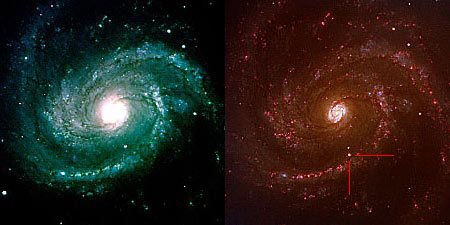I blogged a little while back about a new supernova in the spiral galaxy M100. It’s probably hitting its peak brightness right now, and will soon begin to fade away into obscurity. In the meantime, the folks south of the border– way south, in Chile– have weighed in, observing the exploded star with the mammoth 8-meter Very Large Telescope (yes, that’s its real name).
The picture above (click it for a big 800 kb version) shows an M100 “before and after” shot. The image on the left was taken in 2002, and the one on the right was taken just a few days ago. I marked the supernova to make it easier to see. On the left image, you can see the bright star above the supernova; it may look brighter on the left than on the right because the exposure times were different, and the images were processed differently.
There’s an interesting thing to see right away in the image: the supernova is not in a spiral arm, it’s in the gap between two arms. The spiral arms are big, obvious features in the galaxy because clouds of gas and dust get compressed in them. This triggers star formation, which means you get lots of dinky, dim stars, but also a handful of bright ones. These bright ones are really bright, which in turn light up the gas clouds, which in turn make the arms obvious features.
Now, bright, massive stars don’t live long (a million or so years) and then they explode as supernovae, so you expect to see them in the spiral arms, because they don’t live long enough to make their way out. But this one, SN2006X, is not in a spiral arm. What gives?
What gives is that there are two types of supernovae. When a low-mass star like the Sun ends its life, its core gets compressed into a dense ball called a white dwarf. I explain how these can explode in yet another previous entry. Anyway, stars like the Sun can live for billions of years, so they live long enough to move out of their parent spiral arm. So you don’t necessarily expect to see this kind of supernova (called a Type I) in an arm. It might be, if coincidentally the star happened to be drifting through an arm when it blew up, but it doesn’t have to be, like the other kind of supernova does.
So just by looking at this picture, you can guess the star that blew up was an old, low-mass Type I. And you’d be right!
Usually it takes a lot of work to interpret astronomical images, but sometimes you can tell a lot just at a glance.’
